I had my first Natural Dyeing class at the Oregon College of Art and Craft last week. We started by walking the campus and collecting various autumn flora: fallen oak and maple leaves, pink-backed cherry leaves, fresh comfrey, spotted dying blackberry leaves, walnut hulls, tupelo, madrone and walnut leaves, Indian blood grass, and anything else that caught our eye. The ostensible purpose of this was to collect material to make our own contact dyed projects, but really it was to get us excited about natural dyeing. This time of year in the Pacific Northwest the ground is littered with dyestuffs, and the quick and easy method we learned yielded pattern as well as color.
Once we collected our leaves, we laid them out onto fabric or paper, and either rolled up our fabric tightly around a stick (or for added color, around a rusty iron nail) or accordion folded and clamped for a shibori effect. These packets are then simmered in a water bath for an hour, and then removed and unwrapped.
What I found most interesting about this technique is that there is really very little dye in individual leaves (for the most part tannic acids) but because of the wrapping or clamping, the color can’t migrate anywhere other than onto the fabric or paper. In other words, the opposite of leveling. In a lot of cases, the color transfer is more akin to printing— the fabric or paper is not really dyed per se, but stained or imprinted with the actual leaf color, giving pinks or greens which don’t exist as an actual dye. Our instructor cautioned us as much, saying that these colors will fade with washing or over time. That said, there definitely was dyeing of fabric around the periphery from the tannic acids, and also where the rusty nails provided an iron mordant.
Here is a leaf print where I had an iron plate clamped to the outside of my fabric packet:
And likewise wrapped around a large rusty nail:
Here is the difference of the dyestuffs on cellulose. For one, I didn’t get my packet wrapped tightly enough and the colors ran. For another, the yellows and greens remained printed while the tans of the tannic acids didn’t penetrate as much. I expect this to be a function of the density of the cellulose in paper form, and I would expect better tans on cotton yarn:
This technique also led me to revisit my forays into dyeing with candy. I’d encountered poor results with a lot of candies that contained very little dye. So I tried some candy contact dyeing:
The candy melted pretty quickly, so it was hard to keep the fabric tight, but the dye migrated onto the fabric rather than into the dye pot. I can see some candy-related shibori in my future!
I’d also encountered some inexpensive pomegranates at the grocery store last week, and per Rachel’s last post I bought them for some seasonal dyeing. Pomegranates contain ellegic acid, which are yellow tannins, so I thought this would be a quick way to see what sort of coloring I could get from them:
This is one slice of pomegranate:
And here is multiple slices and layers, with the rest of the pomegranate in the dye pot:
Tight wrapping and clamping is the key to good transfer, but whether you are preserving autumn leaves, testing dyestuff potential, or finding another use for seasonal candy, it’s such a quick and easy technique that it’s definitely worth trying.
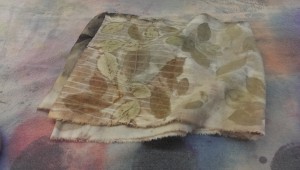
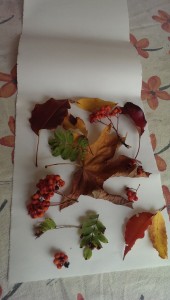
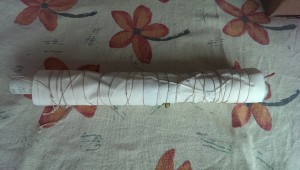
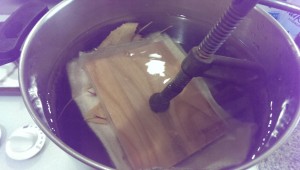



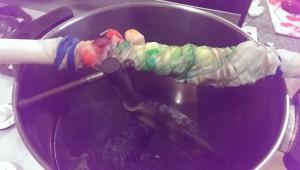
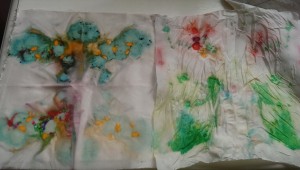
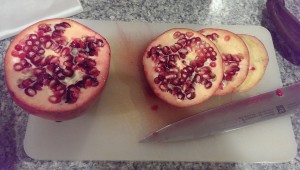


i love how these turned out. That candy looks like a psychedelic Pucci print. I also like the idea that with this technique there is a big element of chance and dye stuffs just doing their thing. Then you get the big reveal at the end of the process.
I read online that some people use a hammer to pound (tap?) the colour out of leaves instead of pressing. The pressing technique would be less stressful on the fabric and the dye stuff though.
I bought some pomegranates today– 2 for £1!
Yeah, the candy was fun. I mostly did that to confirm that there’s a big payoff for very little dye content, and that controlling the leveling is key. Some of the color rinsed out because I didn’t aciduate the water, but that’s easy enough to fix in the future.
And it’s definitely pomegranate season. I always buy them when I see them, but I don’t always get around to eating them because they’re fiddly. At least this way they’re not going to go to waste. I think the bulk of the ellegic acids are in the skin/pithy part, so you can have your pomegranate and eat it too.
That’s interesting that people use a hammer to massage in the leaf color. I used to use a ball peen hammer to make gaskets for old Italian cars back in the day. I think silk holds up pretty well to pounding…in that indigo book I gave you there’s a section where they show people burnishing the indigo-dyed silk to make it shine like metal. I might have to give hammering a try!